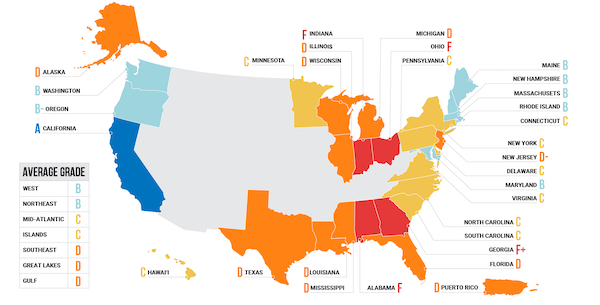
Oregon Squeaks out an Above Average Score
Surfrider Foundation released today our National State of the Beach Report illustrating that 74% of coastal states are doing a mediocre to poor job of managing our nation's shoreline and preparing for sea level rise. This year, Oregon squeaked by with an above average score (B-) putting our fair state, along with California and Washington, as national leaders in this type of coastal policy. But just how is it that the Beach Bill state of Oregon has a score that falls shy of its neighbors to the north and south, what can we as a state do to improve, and how can you help out?
First, some national perspective. The illustration above demonstrates Oregon's State of the Beach score against that of the rest of our nation. Clearly we're doing pretty good as a state. But the climate crisis is dire. Sea level rise is real. The earth is getting hotter and our policies need to reflect the rising tide. Oregon, on top of all this has some serious acute hazards (i.e. Cascadia Subduction Zone earthquake/tsunami) we need to be thinking about, just another great reason to invest in resilient climate adaptive policies for our coast. Oregon has bigger and badder storms, associated wave heights and our chronic hazards are equally daunting for our coastline. So what is it we're not doing or what is it could we be doing better in Oregon to better prepare our coast for resiliency in the wake of climate change?
The criteria for the scoring looks at 4 major areas of coastal policy and implementation based on recommendations and expectations by the federal Coastal Zone Management Act: sediment management, coastal armoring, development and sea level rise. In looking into these policies for Oregon, we generally fall short of our neighbors on development standards for setbacks, limits to new development in hazard zones and regional or littoral cell management of our beaches. Let's explore each of these areas a little more to understand where Oregon prevails and can stand to improve.
 States were graded on a set of twelve criteria based on these 4 major categories.
Download Oregon's complete scorecard.
States were graded on a set of twelve criteria based on these 4 major categories.
Download Oregon's complete scorecard.
Littoral cells are more or less defined as regions of the coast which sand supply is maintained - such as between two headlands or various other geographical features of the coast. They are critical to understand and study at a system level for managing sand supply on our beaches and thus enormously important to us as recreational users. While for over two decades Oregon has promoted littoral cell planning for shoreline development, the state has failed to support system level planning, relying on the more rigid foundation of Goal 18 to guide development and armoring at the local level. This statewide land use goal has however served the state fairly well when comparing the historical growth of development along our coast to that of our southern neighbors, but has some limitations for system level planning into the future through littoral cell and regional scale sand/sediment management.
When considering future development along the Oregon coast, this is a standout area that Oregon could reasonably act today on a number of levels. To put it bluntly, we've put our heads in the sands when it comes to slowing the growth of coastal development that puts homeowners in harms way and potentially undermines our public beaches. And that's not because government is green lighting every system development opportunity they get...its consumer demand. Very often if property owners are met with resistance to develop, they will litigate - that's a cold hard reality and often the weight on the shoulders of many coastal planners. Improving development policies from standardizing setback requirements with peer reviewed geologists to restricting new development in hazard zones are easy ways we can prevent development from being built in harms way. There really is a lot that Oregon can do to prevent future development that undermines our beaches and puts homeowners in harms way.
So despite our generally above par grade for the nation, above are just a few areas where Oregon can reasonably improve. And, it should be noted that Oregon is doing some really fabulous things - like the really cool local and now statewide Envision Coastal Futures project that examine various policy scenarios for adapting to acute and chronic hazards and climate change.
Download the Full State of the Beach Report
Help raise our score! One way to give feedback on these coastal planning issues is to participate in the state's assessment of the Coastal Management Program. The Oregon Coastal Management Program (OCMP), a division of Oregon’s Department of Land Conservation and Development (DLCD), is undergoing strategic planning that will guide the program’s work over the next five years. The agency is seeking feedback on many coastal management issues from coastal hazard planning to marine debris so it's a broad and great opportunity to provide feedback!




